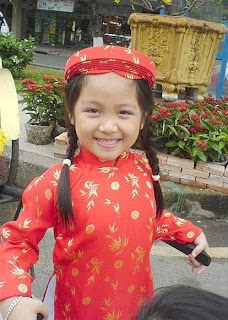“There is a popular saying in anthropology, ‘One must immerse in an unfamiliar world in order to understand one’s own.’” – From the movie “The Nanny Diaries”
One of the things my travel buddies and I agreed to do in Vientiane was to watch the sunrise along Mekong River. Unfortunately, the sky was cloudy on the two days that we woke up very early in the morning to accomplish this. On the second day when we again failed to see the sunrise, we decided to just walk around the city. We chanced upon a young monk sitting alone in the backyard of Inpeng Temple. His name was Khang Pian, a 22-year old monk. We first asked him if it was okay to take a photo of him and he said yes. When we sensed that he was open to have a chat with us, we immediately bombarded him with questions about Buddhism and monks.
Why did you decide to be a monk?
How long have you been a monk?
Do you have to be a monk forever?
What does a monk do, exactly?
What do you do when you wake up in the morning?
Do you have TV inside the temple?
Do you eat meat? (Yes, he does, not all monks are vegetarian pala.)
Is Buddha a girl or a guy? Do you pray to Buddha?
Do you study in a regular school or just inside the temple?
Do you wear your orange robe to school or do you wear ordinary clothes?
Why do you wear orange robe? Why not pink? (kidding, we did not ask this last question.)
These were questions that were asked of him (sometimes even simultaneously) and to which he sincerely and patiently answered. He did not get tired of answering our questions, no matter how stupid the queries were. Kami nga ata ang napagod at nagutom sa kakatanong sa kanya. We soon left him alone after our 40-minute chat, as he was about to get ready for school.
The answered questions only meant another set of questions needs to be asked. The answers led to more questions, ika nga. And now that I’m back in Manila with no more orange robe-clad monks roaming around the streets, I need to find the answers from someone or something else. No, I won’t be entering a Buddhist temple and be a Buddhist nun, neither will I be reading that Idiot’s Guide to Religion. But before I go search for the answers, I think I need to know from where the questions were coming, from where the curiosity about Buddhism and other religion lies.
I haven’t been to church in about ten years (hmm, parang narinig ko na ‘tong kantang to ah, guess the title and singer). I stopped participating in Catholic ceremonies a long long time ago. I once read, “Waiting is better than actions I do not believe in” (from Hope for the Flowers). So I waited patiently. I waited for some miraculous event to happen to my life that would explain to me this thing called religion and faith. The answer never came, as expected.
Now, I just realized that the curiosity lies in the assumption that if I try to understand other religions, their doctrines, creed, dogma or what have you, I will get to understand the Catholic religion more and be a better Catholic? …Or maybe not.
I guess as I continue to search for the answers, I will just remember Kahlil Gibran’s thoughts on religion and faith – and strive to make my daily life my temple, my religion, and my prayer.
Kahlil Gibran on Religion
Have I spoken this day of aught else?
Is not religion all deeds and all reflection,
And that which is neither deed nor reflection,
but a wonder and a surprise ever springing in the soul,
even while the hands hew the stone or tend the loom?
Who can separate his faith from his actions,
or his belief from his occupations?
Who can spread his hours before him, saying,
“This for God and this for myself;
This for my soul, and this other for my body?”




